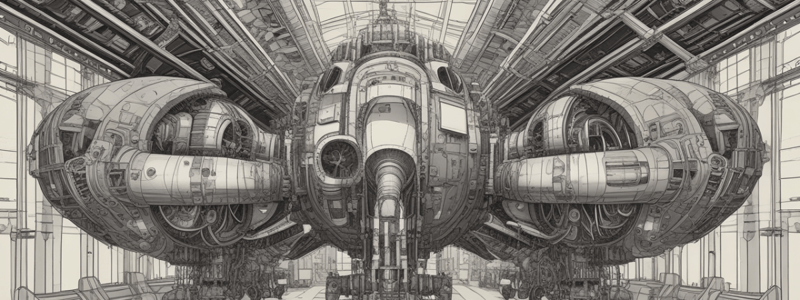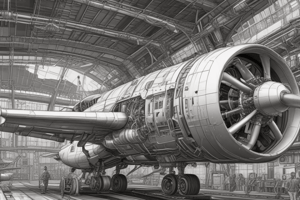Podcast
Questions and Answers
What is the alternative method to calculate bend allowances when the Bend Allowance Chart is not available?
What is the alternative method to calculate bend allowances when the Bend Allowance Chart is not available?
- Using the bend allowance formula (correct)
- Subtracting the flat dimension from the overall dimension
- Using the setback for each bend
- Dividing the bent object into flats and bend allowances
What is the purpose of calculating the bend allowance in tube bending?
What is the purpose of calculating the bend allowance in tube bending?
- To calculate the overall length of the bent object
- To calculate the flat dimension
- To obtain a smooth bend without flattening the tube (correct)
- To determine the minimum bend radius
How is the development length calculated?
How is the development length calculated?
- By adding the flat dimensions and bend allowances
- By multiplying the flat dimensions and bend allowances
- By subtracting the setback from the overall dimension
- By dividing the bent object into flats and bend allowances, then adding them up (correct)
What is the minimum bend radius in tube bending?
What is the minimum bend radius in tube bending?
What is the acceptable method of bending soft, non-heat-treated aluminium tubing in an emergency?
What is the acceptable method of bending soft, non-heat-treated aluminium tubing in an emergency?
What is the purpose of calculating the flat dimension?
What is the purpose of calculating the flat dimension?
What is the formula for calculating the bend allowance?
What is the formula for calculating the bend allowance?
What is the result of adding up the flat dimensions and bend allowances?
What is the result of adding up the flat dimensions and bend allowances?
What is the primary function of the handle and slide bar in the simple hand bender?
What is the primary function of the handle and slide bar in the simple hand bender?
How is the forming die on the mechanical tube bender calibrated?
How is the forming die on the mechanical tube bender calibrated?
What is the purpose of bending a replacement tubing to a specified number of degrees?
What is the purpose of bending a replacement tubing to a specified number of degrees?
Why is a tube cutter not suitable for stainless steel tubing?
Why is a tube cutter not suitable for stainless steel tubing?
What is the recommended margin of safety when cutting a new piece of tubing?
What is the recommended margin of safety when cutting a new piece of tubing?
What is the purpose of marking the tube with a felt-tip pen or scriber before cutting?
What is the purpose of marking the tube with a felt-tip pen or scriber before cutting?
What should be avoided when using a tube cutter to cut stainless steel tubing?
What should be avoided when using a tube cutter to cut stainless steel tubing?
What is the primary difference between a hand bender and a mechanically operated tube bender?
What is the primary difference between a hand bender and a mechanically operated tube bender?
What is the first step in forming a single flare?
What is the first step in forming a single flare?
What is the purpose of a double flare?
What is the purpose of a double flare?
Why is it important to check the flared end of the tube after forming a single flare?
Why is it important to check the flared end of the tube after forming a single flare?
What is the main advantage of using flareless fittings in high-pressure systems?
What is the main advantage of using flareless fittings in high-pressure systems?
What is the purpose of the pre-setting tool in flareless fittings?
What is the purpose of the pre-setting tool in flareless fittings?
What should be done to ensure a secure connection with a flareless fitting?
What should be done to ensure a secure connection with a flareless fitting?
Why is it important to avoid over-tightening when forming a single flare?
Why is it important to avoid over-tightening when forming a single flare?
What should be checked for after forming a double flare?
What should be checked for after forming a double flare?
What is the primary function of a mandrel in fabricating hose assemblies?
What is the primary function of a mandrel in fabricating hose assemblies?
What is the common but dangerous method of removing skived pieces of rubber from a hose?
What is the common but dangerous method of removing skived pieces of rubber from a hose?
What is the typical procedure when a failure occurs in a flexible hose equipped with swaged end fittings?
What is the typical procedure when a failure occurs in a flexible hose equipped with swaged end fittings?
What is the purpose of a protractor in fabricating hose assemblies?
What is the purpose of a protractor in fabricating hose assemblies?
What is the recommended tool for cutting the hose to the required length?
What is the recommended tool for cutting the hose to the required length?
What is the purpose of a marking pencil in fabricating hose assemblies?
What is the purpose of a marking pencil in fabricating hose assemblies?
What is the procedure when a failure occurs in a hose assembly equipped with reusable style end fittings?
What is the procedure when a failure occurs in a hose assembly equipped with reusable style end fittings?
What is the purpose of adding 5%–8% to the determined hose length?
What is the purpose of adding 5%–8% to the determined hose length?
What is the purpose of a thickness gauge in fabricating hose assemblies?
What is the purpose of a thickness gauge in fabricating hose assemblies?
What is the purpose of wrapping the circumference of the hose with masking or plastic electrical tape?
What is the purpose of wrapping the circumference of the hose with masking or plastic electrical tape?
What should be done after cutting the hose to the required length?
What should be done after cutting the hose to the required length?
Why should a vice not be over-tightened on thin-walled lightweight fittings?
Why should a vice not be over-tightened on thin-walled lightweight fittings?
What is the purpose of screwing the hose anti-clockwise into the socket?
What is the purpose of screwing the hose anti-clockwise into the socket?
How should the hose be turned after screwing it into the socket?
How should the hose be turned after screwing it into the socket?
What is the purpose of assembling the nipple and nut?
What is the purpose of assembling the nipple and nut?
What is the purpose of the socket in the hose end fitting installation?
What is the purpose of the socket in the hose end fitting installation?
Flashcards are hidden until you start studying
Study Notes
Calculating Bend Allowances
- Use the Bend Allowance Chart if available, otherwise use the bend allowance formula: angle of bend = 2πR / 360°
- Calculate flats by subtracting the setback for each bend from the overall dimension
- Calculate overall length by dividing the bent object into flats and bend allowances, and numbering them progressively
Tube Bending
- Objective: obtain a smooth bend without flattening the tube
- Minimum bend radius: 2.5 to 3 times the OD
- Tube bending methods:
- Hand-operated tube bender
- Mechanical tube bender
- Hand bending (for soft, non-heat-treated aluminium tubing smaller than 1/4 inch in diameter)
Tube Cutting
- Cut new tubing 10% longer than the tube being replaced
- Cutting methods:
- Fine-tooth hacksaw
- Roller type tube cutter (for soft metal tubing like copper, aluminium, or aluminium alloy)
- Avoid using tube cutters on stainless steel tubing as it tends to work harden the tube
Tube Flaring
- Single flare: use a tube flare tool to form the flare
- Double flare: used with small diameter soft aluminium alloys to reinforce the flare
- Flareless fitting: used for high-pressure systems, requires pre-setting with a specialized tool
Hose Assembly Fabrication
- Basic hand tools required:
- Bench vice
- Hose cut-off machine
- Fine-tooth hacksaw
- Open-end wrench sets
- Sharp knife
- Slip-joint pliers
- Oil can
- Marking pencil
- Steel ruler
- Thickness gauge (leaf type)
- Protractor
- Recommended tools:
- Mandrel kit (protects sealing surfaces, supports inner tubes, and guides fitting nipples into hoses)
Hose Assembly Procedures
- Determine the necessary hose length from the table and diagram
- Add 5%-8% to allow for expansion or contraction from pressure application
- Wrap the circumference of the hose with masking or plastic electrical tape at the cut-off point
- Cut the hose to the required length using a cut-off machine
- Blow the hose clean with filtered shop air after cutting
- Remove the tape and clamp socket in a vice
- Install the hose end fitting, ensuring a square cut and cleanliness
- Avoid over-tightening the vice on thin-walled lightweight fittings
Studying That Suits You
Use AI to generate personalized quizzes and flashcards to suit your learning preferences.


